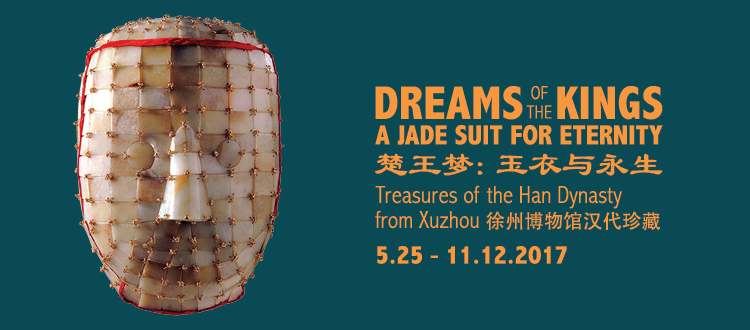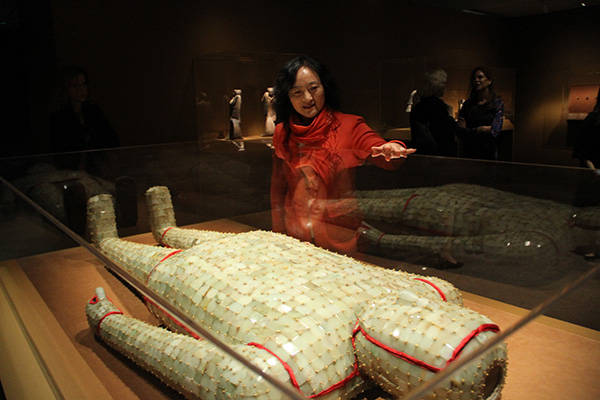-
China Institute Gallery Presents Dreams of the Kings
A rare shroud of precious stones designed to protect and glorify a king in the afterlife is on view at China Institute Gallery’s new exhibition, Dreams of the Kings: A Jade Suit for Eternity, Treasures of the Han Dynasty from Xuzhou through November 12, 2017. More than 76 objects originating from royal tombs dating from the Western Han Dynasty (206 BCE – 8 CE) are being exhibited in the U.S. for the first time. Ranging from terracotta performers to carved stone animal sculptures, the objects are extraordinary testimony to customs and beliefs surrounding life and death during the Western Han Dynasty, one of China’s golden eras. The exhibition is accompanied by a fully illustrated bilingual catalogue.

“People during the Han Dynasty regarded death as birth and longed for immortality,” said Willow Weilan Hai, Director, China Institute Gallery. “To prepare for the afterlife, they constructed their tombs to be eternal residences” Dreams of the Kings: A Jade Suit for Eternity, Treasures of the Han Dynasty from Xuzhou is curated by Li Yinde, Director Emeritus of the Xuzhou Museum, and directed by Willow Weilan Hai, Director of China Institute Gallery. The exhibition will travel to the Nelson-Atkins Museum of Art in Kansas City, Missouri, from December 2017 – April 2018.
EXHIBITION OVERVIEW
Dreams of the Kings: A Jade Suit for Eternity, Treasures of the Han Dynasty from Xuzhou is divided into four sections.
- The King’s Guards explores the sculptures of the guardians of the kings, including soldiers and a warrior on horseback that were made to protect the kings in their afterlife.
- Dreams of Eternity focuses on the jade burial suit, which fully covers the body with jade tiles. Excavated in 1994–95, the suit consists of 4,248 tiles, more than any other jade suit discovered to date. One of the earliest ever made (ca. 175 BCE), it is bound with a rare gold thread, a signifier of the highest rank.
- Rapt by Jade surveys the importance of jade during the Han Dynasty. A carved jade pendant of a dragon with a hole below its eye may have been used to tie the piece on the body to protect its owner. During the Han Dynasty, jade was also ground into a power to be used as medicine.
- Life in the Afterlife focuses on the many everyday objects used in the afterlife including bronze vessels and belt buckles.
EXHIBITION PUBLICATION
The exhibition’s 216-page catalogue in English and Chinese is edited by Willow Weilan Hai, Director of China Institute Gallery. It includes several essays by Li Yinde, Director Emeritus and Senior Researcher, Xuzhou Museum; Colin Mackenzie, Senior Curator of East Asian Art, Nelson- Atkins Museum of Art; and Wang Zijin, Professor of Beijing People’s University.

EXHIBITION-RELATED PROGRAMS
Fall Lecture Series: The Glories of the Han Dynasty Wednesdays, September 20, 27; October 4, 11, 18, 6:30–8:00 p.m. With topics elaborating on themes touched upon by China Institute’s exhibition Dreams of the Kings: A Jade Suit for Eternity, Treasures of the Han Dynasty from Xuzhou, this five-week lecture series will explore the culture of the Han Dynasty through its history, literature, economy, politics, scholarship, and visual arts. Each lecture will be delivered by a prominent scholar covering a crucial aspect of Han Dynasty civilization, including the growth of the Silk Road, the role of Confucianism, and the writing of Sima Qian’s Records of the Grand Historian. Lecturers include Yu Renqiu, Professor of History, SUNY Purchase; Michael Nylan, Professor of History, University of California, Berkeley; Susan Beningson, Assistant Curator of Asian Art, Brooklyn Museum; Lillian Tseng, Associate Professor of East Asian Art and Archaeology, Institute for the Study of the Ancient World, New York University; and Valerie Hansen, Professor of History, Yale University.
Individual Tickets: $10 Members/$15 Non-Members
Full Series Tickets: $40 Members/$60 Non-Members
For more information and registration, visit www.chinainstitute.org, or contact 212-744- 8181.UPCOMING EXHIBITION
Art of the Mountain: Through the Chinese Photographer’s Lens
February 8 – December 2, 2018
Mountains, in Chinese legends, are the pillars that hold up the sky. Mountains were seen as places that nurture life. Their veneration took the form of rituals, retreat from social society, and aesthetic appreciation through the art of their vast beauty – some of the many ways that nature played and continues to play a defining role in Chinese culture. The exhibition — with over 70 photographs by more than 20 contemporary photographers — will present the geography, history, culture, life, and art that is associated with or derived from mountains.
ABOUT CHINA INSTITUTE
China Institute advances a deeper understanding of China through programs in education, culture, business, and art in the belief that cross-cultural understanding strengthens our global community. In 2016, China Institute celebrated both its 90 th anniversary and the 50 th anniversary of China Institute Gallery. Founded in 1926 by a group of American and Chinese educators, China Institute in America is the oldest bicultural non-profit organization in the U.S. to focus exclusively on China.
The organization promotes the appreciation of Chinese heritage and provides the historical context for understanding contemporary China. Programs, activities, courses, and seminars are offered on the visual and performing arts, culture, history, music, philosophy, language, and literature for the general public, children, and teachers, as well as for business.
ABOUT CHINA INSTITUTE GALLERY
China Institute Gallery, established in 1966, is distinct among the museums of New York City. It was the first in the United States to showcase Chinese art exclusively on a regular basis. Today, China Institute Gallery is New York's only non-commercial exhibition space solely dedicated to Chinese art and is known for its innovative thematic and scholarly exhibitions, publications, and related art education programs. China Institute is located at 100 Washington Street, New York, NY 10006, with a temporary entrance at 40 Rector Street. During exhibitions, China Institute Gallery is open Monday – Friday, 10 a.m. to 5 p.m., Thursday 10 a.m. to 8 p.m., and Saturday, 11 a.m. to 5 p.m. Admission is $10 for adults, $5 for seniors and students, free for members and children under 16, and free on Thursdays from 5 to 8 p.m. For more information, call 212-744- 8181 or visit chinainstitute.org, Facebook, Twitter or Instagram.
ABOUT THE XUZHOU MUSEUM
The Xuzhou Museum, established in 1959, is located at the northern foot of Yunlongshan (Cloudy Dragon Mountain) on the old site of the temporary palace used by the Qianlong emperor (r. 1736–95) during his southern inspection tours. Expanded three times over the years, the museum now consists of four parts: the main exhibition hall; the Western Han dynasty (206 BCE–220 CE) quarry site; the Eastern Han dynasty (25–220) mausoleum of the King of Pengcheng in Tushan (Soil Mountain); and the Qing dynasty (1644–1911) temporary palace of Gaozong, the Qianlong
emperor, and its corridor of steles. The museum’s rich collection of artwork spans the Neolithic period to the last imperial dynasties of the Ming (1368–1644) and Qing (1644–1911), and extend to the contemporary period. Its outstanding collection of Han dynasty artifacts uniquely illustrates the characteristic Han culture of Xuzhou.


